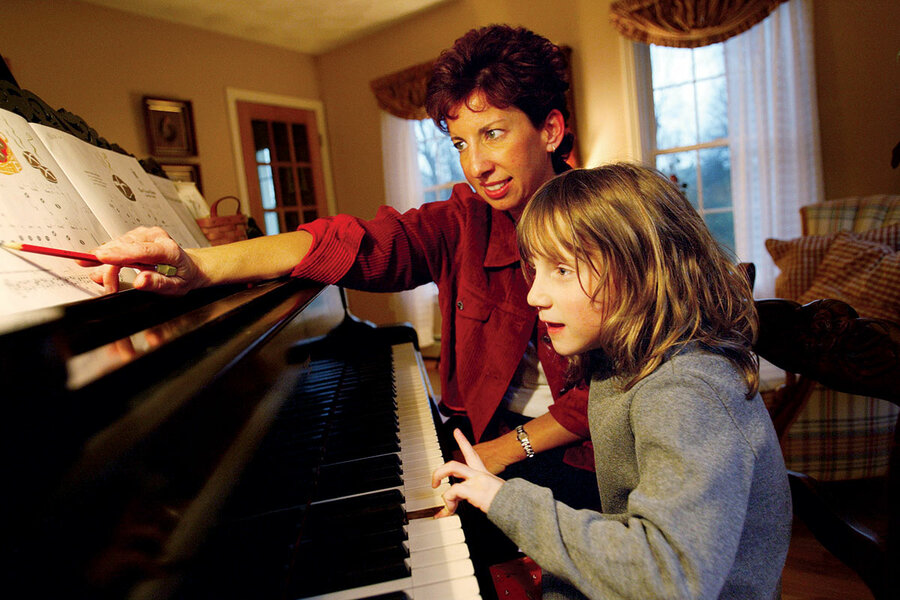I discover my own, new way to play
Loading...
The sounds of my new piano filled the house: three familiar chords followed by a roll of arpeggios. It was Greg, the ponytailed piano tuner, taking the instrument for a test-drive after tightening and testing it for 45 minutes. His song of choice: Billy Joel’s “She’s Always a Woman,” one of my favorites.
I walked to the top of the stairs and listened. I’m the pianist in the family, unaccustomed to hearing another play. Does the music inhabit the house as thoroughly when I play? I know only what I hear from the piano bench, which ranges from OK to “Ouch!” but this was different. The music sang and swayed; it seemed to flow from every corner of every room.
Once it ended, I tiptoed downstairs. Greg was back to tuning, tinkering with the highest notes. I asked him where I could buy the sheet music.
Greg smiled. “There’s no music,” he said. “I’m playing by ear.”
Just as I suspected. Greg is a piano tuner. He probably has perfect pitch. He doesn’t need sheet music to play “She’s Always a Woman.” He just ... plays it.
Now he was finishing up, checking the piano’s humidifier, showing me how to add water to it. His work was over, but mine was just beginning.
In the year since I bought the piano, I’ve been playing more than I have in decades. But my sheet music is tattered and yellow. The Beethoven sonatas and Brahms intermezzos bear penciled critiques from my teachers in high school: “Softer!” “Count!” And the shameful but necessary “Practice left hand alone.”
This doesn’t help my ego, laboring on pieces I used to breeze through. But I have to start somewhere.
I was trained on the stalwarts: “Für Elise,” “Moonlight Sonata,” Bach preludes and fugues. I loved it all, loved it so much that for years I dreamed of being a concert pianist. I would play Rachmaninoff’s Piano Concerto No. 2 with a full symphony orchestra. The audience would leap to its feet when I pounded those last four triumphant chords.
It didn’t take long for me to realize the truth – that someone who is terrified to perform should probably not count on a concert career. But I kept the music alive: listening, playing when I could, accompanying my children at music festivals. For all of this, though, there was printed music, notes on paper.
Listening to Greg made me want to change that, as if freeing myself from the notes would free me in other ways, too. This was about more than piano repertoire. I’d come to think of my playing as the aural equivalent of coloring inside the lines. But the habits of a lifetime are hard to ignore. Playing “She’s Always a Woman” by ear became a holy grail for me. I would free myself up; I would let the music ripple out.
Every day I tried, first one chord combination and then another. Unsure of the key, unsure of myself – it was anything but improvisational bliss.
A few weeks ago, my need to play the song became so insistent that I gave in and bought a piano solo arrangement. Within minutes I had paid a pittance to print out four pages of music that were just the right degree of difficulty. I propped up the pages on the piano’s music stand and played those opening chords: E flat major, F, B flat major. How much sense they made when I saw them on the page! The piano keys finally felt right beneath my fingers. The arpeggios fell into place. The melody soared above them.
The more I played the piece, the freer I felt. I added dynamics, crescendos, and diminuendos. It dawned on me that reading music is a gift, too, just as playing by ear is. It’s a skill to treasure.
By now I’ve played the piece so many times that I’m starting to memorize it. And once I do, I realize that it won’t matter how the notes made their way into my fingers – only that they have. The freedom lies not in the notes, but in what I do with them.
I still don’t know what I sound like from the top of the stairs. But I have an idea.







